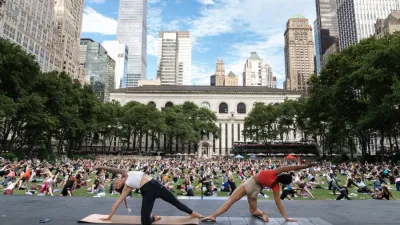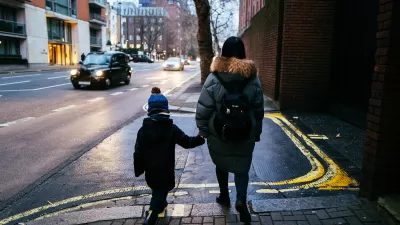Cars kill us and drive us crazy; while walking and biking improve our mental and physical health. So why do we design our cities for cars, asks Jeffrey Tumlin.

"Cities have policies that sound good on paper, calling for mixed-use development and walkable neighborhoods, but they also have detailed technical design requirements that don't let that happen," says Tumlin. "Instead, we end up with typical sprawl: it's actually illegal to build anything else."
"When we know that driving makes us fat, sick, dumb, mistrustful, and more likely to die early—but walking makes us fitter, stronger, better able to handle complex reasoning, more loving, and more trustful, why are we in the transportation world spending all of our effort designing around the needs of the car and not walking or biking? When we know the effects of driving on climate change, how could there be any argument?"
"Right now, engineers make many decisions based on something called 'level of service'—basically, how long cars are delayed at certain points. Our goals should be based on people, not cars," he argues. "Right now, a busy commercial street would be judged a transportation failure even though it’s a social and economic success. We need to change the way we measure, so designers can make the right decisions."
FULL STORY: How Better Urban Design Makes Us Healthier, Happier, and Sexier

Alabama: Trump Terminates Settlements for Black Communities Harmed By Raw Sewage
Trump deemed the landmark civil rights agreement “illegal DEI and environmental justice policy.”

Planetizen Federal Action Tracker
A weekly monitor of how Trump’s orders and actions are impacting planners and planning in America.

The 120 Year Old Tiny Home Villages That Sheltered San Francisco’s Earthquake Refugees
More than a century ago, San Francisco mobilized to house thousands of residents displaced by the 1906 earthquake. Could their strategy offer a model for the present?

Opinion: California’s SB 79 Would Improve Housing Affordability and Transit Access
A proposed bill would legalize transit-oriented development statewide.

Record Temperatures Prompt Push for Environmental Justice Bills
Nevada legislators are proposing laws that would mandate heat mitigation measures to protect residents from the impacts of extreme heat.

Downtown Pittsburgh Set to Gain 1,300 New Housing Units
Pittsburgh’s office buildings, many of which date back to the early 20th century, are prime candidates for conversion to housing.
Urban Design for Planners 1: Software Tools
This six-course series explores essential urban design concepts using open source software and equips planners with the tools they need to participate fully in the urban design process.
Planning for Universal Design
Learn the tools for implementing Universal Design in planning regulations.
Clanton & Associates, Inc.
Jessamine County Fiscal Court
Institute for Housing and Urban Development Studies (IHS)
City of Grandview
Harvard GSD Executive Education
Toledo-Lucas County Plan Commissions
Salt Lake City
NYU Wagner Graduate School of Public Service




























